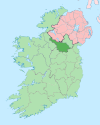- Cloncollow
-
Cloncollow is a townland in the Parish of Tomregan, Barony of Loughtee Lower, County Cavan, Ireland. The townland name is an anglicisation of the Gaelic placename “Cluain Colbhaigh” which means ‘Calva’s Meadow’. An alternative meaning which has been suggested is ‘The border meadow’. The oldest surviving mention of the name is in a 1790 list of Cavan townlands, where it is spelled ‘Cloncallow’. It is bounded on the north by Cavanagh & Agharaskilly townlands, on the east by Carrigan & Mullynagolman townlands, on the south by Togher Lough and on the west by Fartrin & Slievebrickan townlands. Its chief geographical features are Togher Lough, Lough Rud, the Rag River connecting the two Loughs and a drumlin hill reaching to 238 feet (73 m) above sea-level.
Cloncollow is traversed by Slievebrickan lane.
The townland covers 140 statute acres, including 6 acres (24,000 m2) of water. It formed part of the termon lands belonging to Tomregan Roman Catholic Church which were granted to the Protestant Bishop of Kilmore in 1610 as part of the Plantation of Ulster. By a lease dated 6 April 1612 the said bishop granted the lands to Sir Oliver Lambart of Kilbeggan, County Westmeath and Sir Garrett Moore of Mellifont, County Louth. On 17 July 1639 the bishop re-granted the lands to Charles Lambart, 1st Earl of Cavan. Griffith's Valuation of 1857 lists the landlord of the townland as Davis & the tenants as Morton, Lee, Best, Berry and Davis. In the 1911 census of Ireland, there are five families listed in the townland.[1]
The only historic site in the townland is a medieval Togher or causeway at the Rag River outlet of Togher Lake (Site number 176, page 33, Cloncollow townland, “Archaeological Inventory of County Cavan”, Patrick O’Donovan, 1995)
References
External links
Places in County Cavan County town: Cavan Towns Villages Agharaskilly • Aghavoher • Arvagh • Ballinagh (Bellananagh) • Ballyconnell • Ballyhaise • Ballymagauran • Ballymagovern • Bawnboy • Berrymount • Blacklion • Butlersbridge • Canningstown • Cavanagh • Cloncollow • Crossdoney • Cullyleenan • Derryginny • Dowra • Kilcogy • Killashandra • Kilnacreeva • Kilnaleck • Lisnahederna • Milltown • Mountnugent • Mullagh • Mullaghduff • Rakeelan • Redhills • Stradone • SwanlinbarLandforms Black Pig's Dyke • Dún na Rí Forest Park • Glengevlin • Lough Gowna • Lough Oughter • Lough Ramor • Lough Sillan • Magh Slécht • Shannon Cave • Shannon Pot • Slieve Cuilcagh • Slieve RushenCategory:Geography of County Cavan Categories:- Townlands of County Cavan
- County Cavan geography stubs
Wikimedia Foundation. 2010.

